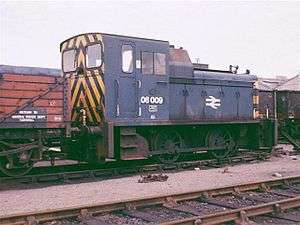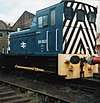British Rail Class 06
The British Rail Class 06 is a class of 0-4-0 diesel-mechanical shunters built by Andrew Barclay Sons and Company from 1958[1] to 1960 for use on the Scottish Region of British Railways. They were originally numbered D2410–D2444 and later given the TOPS numbers 06 001–06 010.
| British Rail Class 06 | |||||||||||||||||||||||||||||||
|---|---|---|---|---|---|---|---|---|---|---|---|---|---|---|---|---|---|---|---|---|---|---|---|---|---|---|---|---|---|---|---|
 06 009 operating as 'works pilot' at Dunfermline Townhill in July 1975. It was withdrawn the following month. | |||||||||||||||||||||||||||||||
| |||||||||||||||||||||||||||||||
| |||||||||||||||||||||||||||||||
| |||||||||||||||||||||||||||||||
| |||||||||||||||||||||||||||||||
Technical details
Engine is a Gardner 8-cylinder 4 stroke "8L3" connected to a Wilson-Drewry CA5 5-speed epicyclic gearbox with Vulcan-Sinclair type 23 fluid coupling and a Wiseman type 15 RLGB gearbox.
While all technically similar, the locomotives had two different designs for the back of the cab, the first 15 locomotives having three windows, the remaining 20, having two.[2]
Numbering
They were originally numbered D2410–D2444. The ten still in service in January 1973, nos. D2413/14/20–23/26/37/40/44, were given the TOPS numbers 06 001–06 010.[2]
| D-number | TOPS Number | Allocation in February 1977 [3] | Image | Status | Notes |
|---|---|---|---|---|---|
| D2410 | Withdrawn | Scrapped | |||
| D2411 | Withdrawn | Scrapped | |||
| D2412 | Withdrawn | Scrapped | |||
| D2413 | 06 001 | Withdrawn | Scrapped | ||
| D2414 | 06 002 | DT | Scrapped | ||
| D2415 | Withdrawn | Scrapped | |||
| D2416 | Withdrawn | Scrapped | |||
| D2417 | Withdrawn | Scrapped | |||
| D2418 | Withdrawn | Scrapped | |||
| D2419 | Withdrawn | Scrapped | |||
| D2420 | 06 003 | ED |  | Preserved | For a considerable time, at Eastfield depot, carried the number 206 003 |
| D2421 | 06 004 | DE | Scrapped | ||
| D2422 | 06 005 | DE | Scrapped | ||
| D2423 | 06 006 | AB | .jpg) | Scrapped | |
| D2424 | Withdrawn | Scrapped | |||
| D2425 | Withdrawn | Scrapped | |||
| D2426 | 06 007 | DT | Scrapped | ||
| D2427 | Withdrawn | Scrapped | |||
| D2428 | Withdrawn | Scrapped | |||
| D2429 | Withdrawn | Scrapped | |||
| D2430 | Withdrawn | Scrapped | |||
| D2431 | Withdrawn | Scrapped | |||
| D2432 | Withdrawn | Unknown | Exported to Italy in 1977, fate unknown. | ||
| D2433 | Withdrawn | Scrapped | |||
| D2434 | Withdrawn | Scrapped | |||
| D2435 | Withdrawn | Scrapped | |||
| D2436 | Withdrawn | Scrapped | |||
| D2437 | 06 008 | DT | .jpg) | Scrapped | |
| D2438 | Withdrawn | Scrapped | |||
| D2439 | Withdrawn | Scrapped | |||
| D2440 | 06 009 | Withdrawn |  | Scrapped | |
| D2441 | Withdrawn | Scrapped | |||
| D2442 | Withdrawn | Scrapped | |||
| D2443 | Withdrawn | Scrapped | |||
| D2444 | 06 010 | Withdrawn | Scrapped |
Withdrawal
With a decline in shunting, BR was forced to reduce its shunter fleet in the 1960s and 70s, resulting in mass withdrawals. The first class 06 locomotive to be withdrawn was D2441 in March 1967 and the last was 06 002 (formerly D2414) in September 1981.
| Year | Quantity in service at start of year | Quantity withdrawn | Locomotive numbers | Notes |
|---|---|---|---|---|
| 1967 | 35 | 1 | D2441 | |
| 1968 | 34 | 9 | D2411–2/15/17–8/25/28/30/32 | D2432 sold into industrial use |
| 1969 | 25 | 5 | 2410/19/27/29/34 | |
| 1970 | 20 | 0 | – | |
| 1971 | 20 | 4 | 2431/35–6/39 | |
| 1972 | 16 | 6 | 2416/24/33/38/42–3 | |
| 1973–4 | 10 | 0 | – | |
| 1975 | 10 | 2 | 06 009/010 | |
| 1976 | 8 | 1 | 06 001 | |
| 1977 | 7 | 1 | 06 007 | |
| 1978 | 6 | 0 | – | |
| 1979 | 6 | 1 | 06 004 | |
| 1980 | 5 | 3 | 06 005–006/008 | |
| 1981 | 2 | 2 | 06 002/003 | 06 003 went into departmental use, now preserved. |
Preservation
_(8061924358).jpg)
A single locomotive survives, number 06 003 (formerly D2420). It was the second last locomotive of the class in service when it was withdrawn in February 1981. It was transferred to the departmental fleet following withdrawal and renumbered 97 804, and used at the Reading Signal Works where it replaced 97 020.[2] After being withdrawn again in 1984, it was sold to Booth's scrapyard in Rotherham (date unknown) before being saved for preservation by the local South Yorkshire Railway based at Meadowhall in Sheffield. Later owned by HNRC and visited several locations before been stored at the Museum of Science and Industry, Liverpool Road, Manchester, and in 2013 was moved into the Heritage Shunters Trust's Collection at Peak Rail, Rowsley.
One locomotive, D2432, was sold to P. Wood Shipbreakers of Queenborough, Kent in 1969. It was exported to Italy in 1977, but its subsequent fate is unrecorded.[2]
Model Railways
In 1963 Hornby Railways launched its first version of the BR Class 06 in OO gauge. Since 2011 Hornby have produced a basic representation of the prototype as part of their Railroad range in BR Blue, whilst past examples have carried a variety of liveries.[4]
An etched brass kit of the 06 is in the range of Judith Edge Kits.[5]
References
- http://www.brdatabase.info/locoqry.php?action=class&type=D&id=6
- Strickland 1983, p. 40.
- NREA Locomotive allocation book & February 1977, p. 4.
- "Hornby BR Class 06". Hornby Railways Collector Guide. Retrieved 1 February 2020.
- "Judith Edge Kits". UK Model Shops. Retrieved 8 January 2013.
- Strickland, David C. (1983). Locomotive Directory. Frimley, Surrey: Diesel and Electric Group. p. 40. ISBN 0-906375-10-X.CS1 maint: ref=harv (link)
- Williams, Alan; Percival, David (1977). British Railways Locomotives and Multiple Units including Preserved Locomotives 1977. Shepperton: Ian Allan Ltd. ISBN 0-7110-0751-9.CS1 maint: ref=harv (link)
External links
| Wikimedia Commons has media related to British Rail Class 06. |